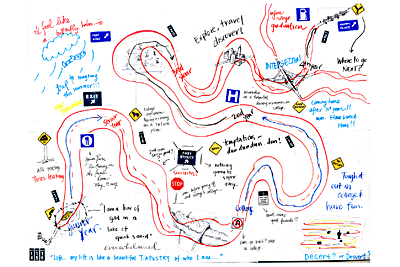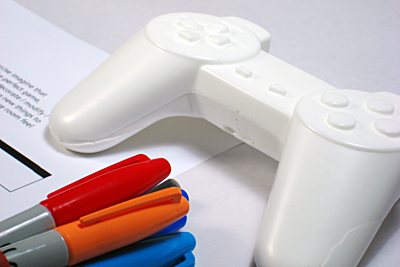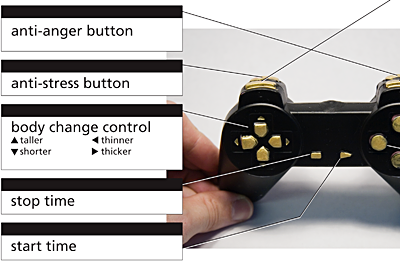Project and
Methods:
Probes:
Blank probes:
Full maps vs. empty maps,
and blank controllers--the need for open space
 A completed roadmap from Living Profiles. Other than the start and end points, the paper was originally blank. Participants were also provided with sheets of stickers to use with the map.
A completed roadmap from Living Profiles. Other than the start and end points, the paper was originally blank. Participants were also provided with sheets of stickers to use with the map.
 A typical completed Women Who Play map. The map began filled with color and inspired little addition by the participants.
A typical completed Women Who Play map. The map began filled with color and inspired little addition by the participants.


 The mythical controller as sent and as complted by two participants.
The mythical controller as sent and as complted by two participants.
Many of the women choose to add their own drawings (middle) or use their
own art supplies (bottom). The women's descriptions were later added as
overlays to the controllers.
The Living Profiles map was a 22"x36" sheet of paper. In the lower left corner was an illustration of a sign saying "today" while in the upper right corner was one saying "21st birthday." The teen participants were also given two sheets of stickers illustrating different road intersections and obstacles, as well as stickers of various road signs. They were given markers and asked to map out the years between today their 21st birthdays. The Women Who Play map was a 24"x24" sheet of paper completely covered in a swirling vortex of colors. They were given markers and asked to label colors with the types of games they represented and then mark out the territory in which they and their friends play.
The Living Profiles map returned much more evocative maps then the WWP maps did. In part this is due to what is being asked for--a list of games is not as compelling as a someone's dreams for the future. This is also due in part to the given materials--the teens were free to use as many or as few of the stickers as possible or to draw their own objects, while the women only had labeling and circling. The biggest difference comes from the blank maps ability to compel the user to fill it in, while the map that was already filled with already felt finished and did not compel the women to add to it.
One probe within Women Who Play did leverage the power of blankness in its design: the mystical controller. When designing the probes for WWP it was a goal for at least one of them to be a dimensional object, different from the majority of the probes that would be printed material or tasks. Early probe ideas had included giving the women a set of stickers or cardboard cut-outs of controller parts and asking them to construct their dream controllers. After many changes, this became the mystical controller. Instead of images of controllers the women received a solid, cast resin controller. This cast controller was pure white and had the same approximate weight of a working controller. They were asked to decorate or design the controller however they wished. (They were given a selection of permanent markers but several choose to use their own art supplies.) They were also given a diagram of the controller and asked to label it functions while thinking of it as a mystical controller capable of controlling anything in their lives. The controller is both literally blank--or at least pure white, it does have a distinct form--and figuratively blank, in that it has been removed from its original purpose and now has no explicit real-world use. The mystical controller returned varied, suggestive, and compelling results.
On first read the women designed the controllers to offer relief from daily annoyances like traffic, bills, and housework. The description of that relief varied from "cleans house," to "live in maid"; and from "control other cars" to "disappear all cars" to "open a portal." (LA traffic featured heavily.) Five of the women had a button to give them money, but as one explained "its not a greedy button, it only adds $10,000 at a time." Another asked only for "extra pocket money." Several seemed concerned with not appearing too selfish with their controllers.
Looking deeper into what kind of life each controller would afford, three distincit groups formed.
There were those who wanted to live a larger-than-life life. To shoot missles out of their cars, to travel the world, and have an infinity of lives.
The next group wanted the controller to remove the drudgery of life to make room for their creative passions. The bills would be paid, house clean, and they could then focus on singing or drawing or animating. They also wanted boosts to their creativity, motivation and energy, but didn't want the controller to do everything for them.
The final group wanted attention and the controller gave them that. They could use it to make others treat them well, to become famous, or to save the world. They could also alter time so that they would never make mistakes or have regrets.
By taking the desires expressed in the controllers and combining them with the values shown in the accomplishment cards, it was possible to create working personas.